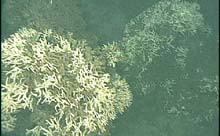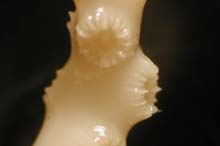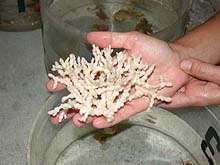
An intact stand of Oculina at Jeff's Reef. Click image for larger view.

Close-up of ivory tree coral, Oculina varicosa. Click image for larger view.

A small piece of ivory tree coral from Sebastian's Reef on Oculina Bank. Coral from this expedition will be analyzed to determine its genetic variability between different sites. Click image for larger view.
Oculina Reproduction
September 3, 2001
Sandra Brooke
Marine Biologist
Harbor Branch Oceanographic Institution
Procreation is the fundamental process that drives all living organisms. In the marine environment, those that swim can gather together to mate, but benthic (bottom-dwelling) species that are attached to a substrate (a hard foundation, e.g., rock), are denied the luxury of movement and must invent some other way of sharing their genetic material. Oculina coral, like many other marine animals, is a "broadcast spawner." This means that the coral polyps release their gametes (eggs and sperm) into the water, where they combine and develop into tiny swimming larvae, called planulae. Spawning occurs in August and September, and the planulae live in the water column for 2-3 wks before they settle on hard substrate and grow into new adult colonies.
Although the larvae can swim, they are so small that the ocean currents carry them along like passive particles. The Florida Current creates a prevailing northerly flow along the continental shelf, but gyres and eddies can create localized flow anomalies. Periodically, the Florida current meanders closer to shore, forcing deep, cold water up over the edge of the shelf, and during the summer, these upwelling events can be strong enough to reach the shallows. Thus, a tiny larva created on the shelf edge can potentially be carried north, south and west, where it may encounter new habitat, or east, where it will be lost in deep water.The Creation of Coral
Because the fate of these larvae is so uncertain, the adults produce large numbers to compensate for lost progeny. A single tiny Oculina polyp, a mere 5 mm in length, can produce as many as 1,400 eggs. Multiply that by the millions of polyps that make up a coral reef, and the numbers are astounding. One might think, then, that coral would be everywhere, but unfortunately, this is not the case. Large areas of the Oculina reefs have died in the past, and we don't understand exactly why. Natural causes, human impacts, or a combination of both may be responsible for the transformation of these beautiful, delicate systems into piles of dead rubble. The Oculina habitat is currently protected from potentially damaging human impacts, and restoration modules have been deployed in an effort to enhance larval settlement. Unfortunately, at the moment, we have no information about natural larval recruitment rates, and therefore no idea when, or if, the damaged areas will recover.
Genetic techniques can provide insight into how the Oculina habitat is formed, and so one of the cruise objectives is to take small samples of live coral from several different locations for genetic analysis. Low genetic variability implies that the reef develops primarily through growth and fragmentation of a few colonies, and that genetic exchange between habitats is very low. In this case, the chance of damaged areas being reseeded by healthy reefs is slim. If, however, genetic variability is high and there is evidence of larval exchange between locations, it may be sufficient to leave the reefs in peace and let nature take its course. Continued research into the biology and ecology of the Oculina reefs is critical if we are to effectively restore and manage this valuable habitat.Today's Explorations
ROV (remotely operated vehicle) pilot Lance Horn found live bottom habitat with gorgonians and sponges on his morning traverse of undulating terrain at the Canaveral site on the northern edge of Oculina Bank. Explorers John Reed and Craig Russell, however, who were diving in the Clelia later in the morning, found nearly complete Oculina mortality over the Canaveral site and only isolated colonies of living Oculina. This was in stark contrast to John Reed's visit to the same area 30 yrs ago, when he found thriving expanses of Oculina heads. Their dive was cut short due to a 2.5-knot current, with an occasional upwelling to surprise them. Concerned that the second Clelia dive of the day, which was also scheduled for Canaveral site, would also experience bottom currents too strong for safe sub navigation, the Seward Johnson II headed south to the Cocoa site, scheduled for tomorrow's dives. When they arrived, Grant Gilmore and Paul Orlando, along with sub pilot Ben Chiong, took the Clelia down 270 ft over a bottom that reminded them of sand dunes but with very few signs of Oculina. The explorers did find the remains of an old wreck -- an Oculina-covered island in an otherwise barren expanse of sand bottom. Convinced that the Cocoa area held little interest, the explorers headed south to Sebastian Reef, where they plan to survey a set of reef balls that were deployed a year ago.
Sign up for the Ocean Explorer E-mail Update List.











































